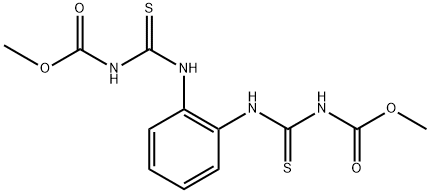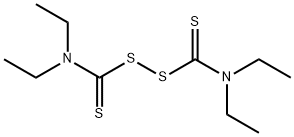Tetramethylthiuram Disulfide , >98.0%(N) , 137-26-8
Synonym(s):
Bis(dimethylthiocarbamoyl) disulfide;Bis(dimethylthiocarbamyl) disulfide;Tetramethylthiuram disulfide;Thiram
CAS NO.:137-26-8
Empirical Formula: C6H12N2S4
Molecular Weight: 240.43
MDL number: MFCD00008325
EINECS: 205-286-2
PRODUCT Properties
| Melting point: | 156-158 °C(lit.) |
| Boiling point: | 129 °C (20 mmHg) |
| Density | 1.43 |
| vapor pressure | 8 x 10-6 mmHg at 20 °C (NIOSH, 1997) |
| refractive index | 1.5500 (estimate) |
| Flash point: | 89°C |
| storage temp. | under inert gas (argon) |
| solubility | 0.0184g/l |
| form | solid |
| pka | 0.87±0.50(Predicted) |
| Water Solubility | 16.5 mg/L (20 ºC) |
| Merck | 14,9371 |
| BRN | 1725821 |
| Exposure limits | NIOSH REL: TWA 0.5 mg/m3, IDLH 100 mg/m3; OSHA PEL: 0.5
mg/m3; ACGIH TLV: TWA 5 mg/m3. |
| Cosmetics Ingredients Functions | ANTIMICROBIAL |
| InChIKey | KUAZQDVKQLNFPE-UHFFFAOYSA-N |
| LogP | 1.730 |
| CAS DataBase Reference | 137-26-8(CAS DataBase Reference) |
| IARC | 3 (Vol. Sup 7, 53) 1991 |
| NIST Chemistry Reference | Thiram(137-26-8) |
| EPA Substance Registry System | Thiram (137-26-8) |
Description and Uses
Tetramethylthiuram disulfide is a rubber chemieal, an accelerator of vulcanization. It represents the most commonly positive allergen contained in the "thiuram mix". The most frequent occupational categories are the metal industry, homemakers, health services and laboratories, building industries, and shoemakers.
Thiram is a protective fungicide applied to foliage to control Botrytis spp. on grapes, soft fruit, lettuce, vegetables and ornamentals. It also controls rust on ornamentals, scab and storage diseases on apple and pear and leaf curl and Monilia on stone fruit. It is used in seed treatments alone or in combination with added insecticides or fungicides to control damping off diseases such as Pythium spp., and other diseases like Fusarium spp. of maize, cotton, cereals, legumes, vegetables and ornamentals.
Safety
| Symbol(GHS) |    GHS07,GHS08,GHS09 |
| Signal word | Warning |
| Hazard statements | H302+H332-H315-H317-H319-H373-H410 |
| Precautionary statements | P273-P280-P301+P312-P302+P352-P304+P340+P312-P314 |
| Hazard Codes | Xn,N |
| Risk Statements | 20/22-36/38-43-48/22-50/53 |
| Safety Statements | 26-36/37-60-61 |
| RIDADR | UN 2771/2811 |
| OEB | B |
| OEL | TWA: 5 mg/m3 |
| WGK Germany | 3 |
| RTECS | JO1400000 |
| Autoignition Temperature | 316 °F |
| TSCA | Yes |
| HazardClass | 9 |
| PackingGroup | III |
| HS Code | 29303000 |
| Hazardous Substances Data | 137-26-8(Hazardous Substances Data) |
| Toxicity | LD50 orally in rats: 640 mg/kg (Gaines) |
| IDLA | 100 mg/m3 |
| Limited Quantities | 5.0 L (1.3 gallons) (liquid) or 5.0 kg (11 lbs) (solid) |
| Excepted Quantities | Max Inner Pack (30g or 30ml) and Max Outer Pack (1Kg or 1L) |





